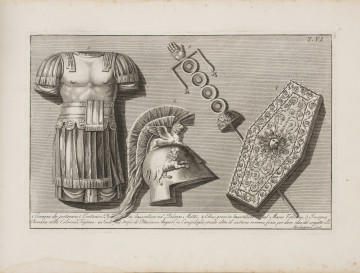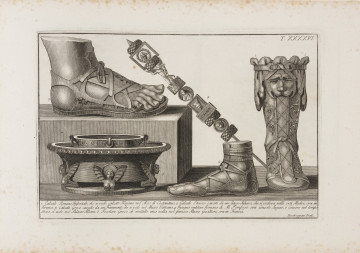
Corazza centurioni, Elmo Greco, Insegna Romana, Scudo | Centurion armour, Greek helmet, Roman banner, Shield
1804
National Museum in Szczecin
Part of the collection: Italian graphics
The engraving shows a mythological scene following a relief in the Giustiniani palace, which is currently housed in the Museo Gregoriano Profano at the Vatican. The nymph Amaltea feeds the baby Jupiter, from a horn of plenty; his mother hid him in Crete in the grotto of Dikte on Mount Aegean (Goat) so that his father, Saturn, would not swallow him. In the arcade leading to the grotto, a young satyr plays a syrinx to drown out the baby's cries. Above the satyr's head, the eagle, Jupiter's companion, splits a hunted hare to feed the chicks sitting in the nest. The serpent, an attribute of Jupiter, slithers along the trunk guarding the nest. Board 26 originates from the album Admiranda Romanorum antiquitatu featuring a title page, a dedication composition and 80 boards with reproductions of notable Roman reliefs, reproduced from the ruins of ancient buildings and monuments from the Capitoline excavations. Pietro Santi Bartoli (1635-1700) authored the engravings, Giovanni Bellori (1613-1696), librarian to Cristina of Sweden and an influential art critic, produced the descriptions, and the entire work, bearing a dedication to Cardinal Flavio Chigi (1631-1693), was published in Rome in 1693 by Domenico de' Rossi (1659-1730). The publication has had several editions, however, the present board dates back to 1797. Pietro Santi Bartoli was a painter, draughtsman, engraver, and antiquarian. He studied under Pierre Lemaire (1612-1688) and Nicolas Poussin (1594-1665) in Rome. However, he devoted himself to printmaking and documenting works of ancient art. A member of the circle of antiquarians, artists, and antiquity enthusiasts. He was considered the leading representative of the archaeological trend among 17th-century Roman engravers. Bartoli published works commemorating masterpieces of art and architecture, which became references for studies of the cultural history of ancient Rome. These included a series of reproductions featuring the reliefs on the columns of Trajan and Marcus Aurelius, Roman paintings, tombs, portraits, gemstones, or lamps. Having been curator of Queen Christina of Sweden's collection, who settled in Rome, he held the office of Conservator of Antiquities (Commissario delle Antichità) in the Church State from 1696 to 1700. Ewa Gwiazdowska
Author / creator
Object type
etching (print)
Technique
etching, copper engraving
Material
watermarked ribber laid paper
Origin / acquisition method
acquisition
Creation time / dating
Creation / finding place
Owner
Muzeum Narodowe w Szczecinie
Identification number
Location / status

1804
National Museum in Szczecin

1804
National Museum in Szczecin

1390 — 1430
National Museum in Szczecin
DISCOVER this TOPIC
Museum of King Jan III's Palace at Wilanów
DISCOVER this PATH
Educational path